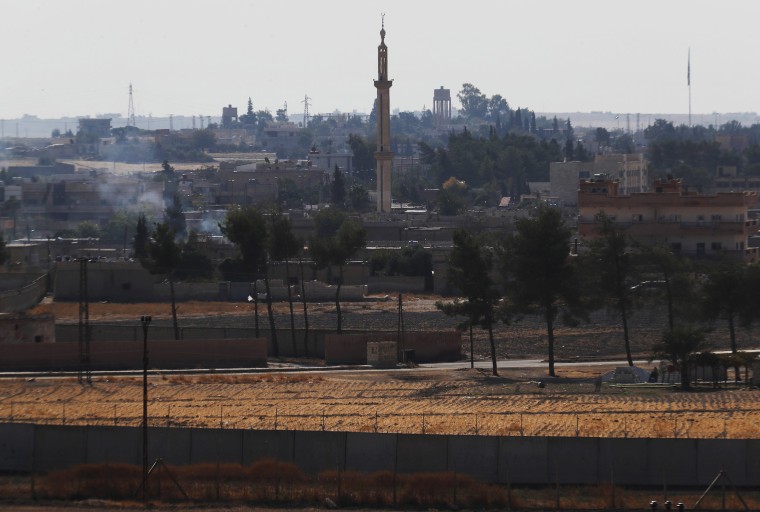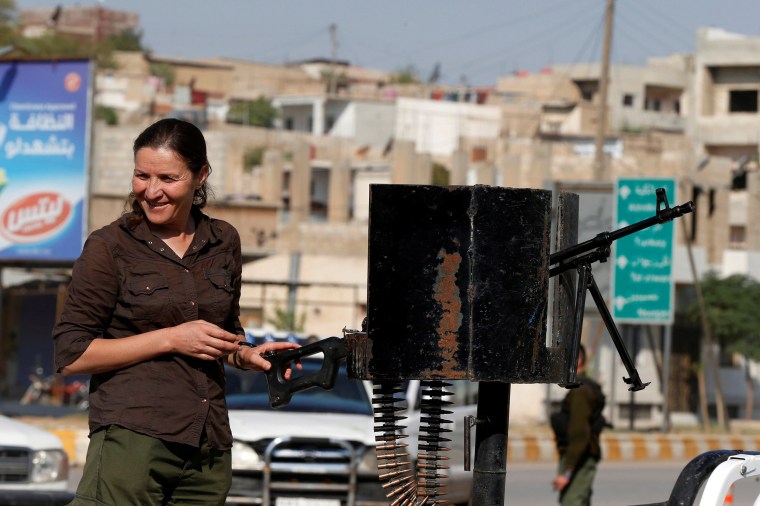LONDON — Russian President Vladimir Putin and Turkish President Recep Tayyip Erdogan spent hours poring over maps of Syria in the Black Sea resort of Sochi on Tuesday, carving up Syrian territory into different geopolitical spheres of influence.
The pair agreed to a deal designed to keep Kurdish forces away from the Syria-Turkey border, enforced by joint Russian and Turkish patrols starting next week. U.S. troops are continuing their journey out of Syria, headed for western Iraq.
The deal came as the five-day pause in fighting brokered by the United States expired — but Turkey now says the deal means hostilities need not resume.
The Russia-Turkey 10-point plan was succinct but will have wide-reaching ramifications for the region, as well as those embroiled in this latest Syrian drama.
Syrian Kurds, America's erstwhile allies, were left waiting to hear the news of their fate from the meeting.
The deal means that from midday Wednesday, Kurdish fighters will have just over six days to withdraw to no more than 20 miles from almost the entire northeastern border.
Ankara will keep sole control of the central section of the border, between the Syrian border towns of Tal Abyad and Ras al-Ayn, the area from which Kurdish fighters were forced to withdraw over the past five days under the U.S.-Turkey deal.

When the new deadline elapses Oct. 29, joint Russian-Turkish troops will patrol a 6-mile-deep area to the west and east of the section of the border captured by Turkey during its invasion.
It’s another blow for Syrian Kurds who want greater self-rule and who had largely managed to achieve this during Syria’s eight-year civil war. Before the Oct. 9 invasion, the Kurds controlled about a quarter of the country — an area rich in oil, water and agriculture. It represented the largest chunk of Syria not controlled by the regime of President Bashar al-Assad.
But under Moscow's and Ankara’s plan, the Kurdish fighters will have to withdraw even further out of the territory that they previously held, dealing a heavy blow to their dreams of regional autonomy and independence.
Kurdish Syrian Democratic Forces have yet to officially respond to the deal.

Tens of thousands of civilians — including 80,000 children — have so far been forced to flee their homes in the fighting, according to the United Nations. Many have headed farther south, deeper into Syrian territory while some thousands have also fled east crossing into Iraq.
The deal is a mixed result for Assad.
His government will be able to extend its control to parts of the Turkish border region, a feat that just weeks ago seemed far-fetched.
However, the deal also means Turkey solidifies its control over parts of Syria — something Assad sees as an affront on his country’s territorial integrity.
During a visit to meet troops in the war-torn northwestern Idlib province Tuesday, Assad described Erdogan as a “thief” and pledged to retake all areas of Syria, state media reported.
Meanwhile, the deal is a coup for Erdogan as it paves the way to achieving his long-term goals in the region.
Firstly, to move Kurdish fighters — whom Ankara sees as a terrorist threat — away from the Turkish-Syrian border.
And secondly, clearing space for some of the more than 3 million Syrian refugees living in Turkey to be resettled there.
It also paints Erdogan as a strongman and a significant global power broker, able to make things happen without the support of the U.S. In a joint press conference Tuesday, Erdogan and Putin emphasized their friendship — and underlined the Turkish leader's shift toward Russia and away from the U.S.
It confirms Russia’s place as the kingmaker in the region, as Moscow swiftly fills the void left by Washington.
The deal also boosts Putin’s preferred outcome of the Syrian conflict, by allowing his ally Assad to regain more territory.
As the lines in the sand in northeastern Syria are being redrawn, the U.S. is rolling out of the region. Washington seems undecided as to how much influence and or presence it wants to maintain on the ground.
The American withdrawal saw the Kurds — close allies of the U.S. in the fight against the Islamic State militant group — turn to Assad’s government and its main ally, Russia, to protect them from Turkey’s offensive.
And it’s not gone totally smoothly either. Iraqi Defense Minister Najah al-Shammari said Tuesday that U.S. troops did not have permission to stay on its territory, according to The Associated Press, despite Defense Secretary Mark Esper’s announcement the day before that that was where they were headed.
President Donald Trump suggested Monday that he would leave some U.S. troops in Syria to protect oil resources from ISIS and other militants.
And the threat from ISIS still looms: NBC News reported last week there is evidence that ISIS fighters have managed to escape from Kurdish prisons since Turkey’s offensive began.